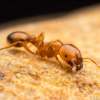Sorry I couldn't get better photos, I just need confirmation that these are, or aren't, from the genus Pheidole.
- Formiculture.com
- Forums
- Gallery
- Members
- Member Map
- Chat

Looks like Pheidole to me. I'd wait for a second opinion though.
Thanks. I don't need a specific identification, just the genus because originally I mistook them for something completely different.
Maybe I need new glasses, which I actually do. But it looks like Solenopsis (invicta?) to me. Their majors look pretty similar to that.
I think S. invicta majors are a little stockier than this.
Maybe I need new glasses, which I actually do. But it looks like Solenopsis (invicta?) to me. Their majors look pretty similar to that.
Look at the spines on the back, rounded gaster, stockiness, and small size against what appears to be fabric.
I agree, based on these images this is Pheidole. I to see what appear to see spines.
Oh I see the spike I think, or like GC said what appears to be spines. Had to closer at my monitor. Maybe more pictures would help a bit, if you can take some more.
"God made..... all the creatures that move along the ground according to their kinds (including ants). And God saw that it was good. Genesis 1:25 NIV version
Keeping:
Formica cf. pallidefulva, cf. incerta, cf. argentea
Formica cf. aserva, cf. subintegra
Myrmica sp.
Lasius neoniger, brevicornis
0 members, 1 guests, 0 anonymous users